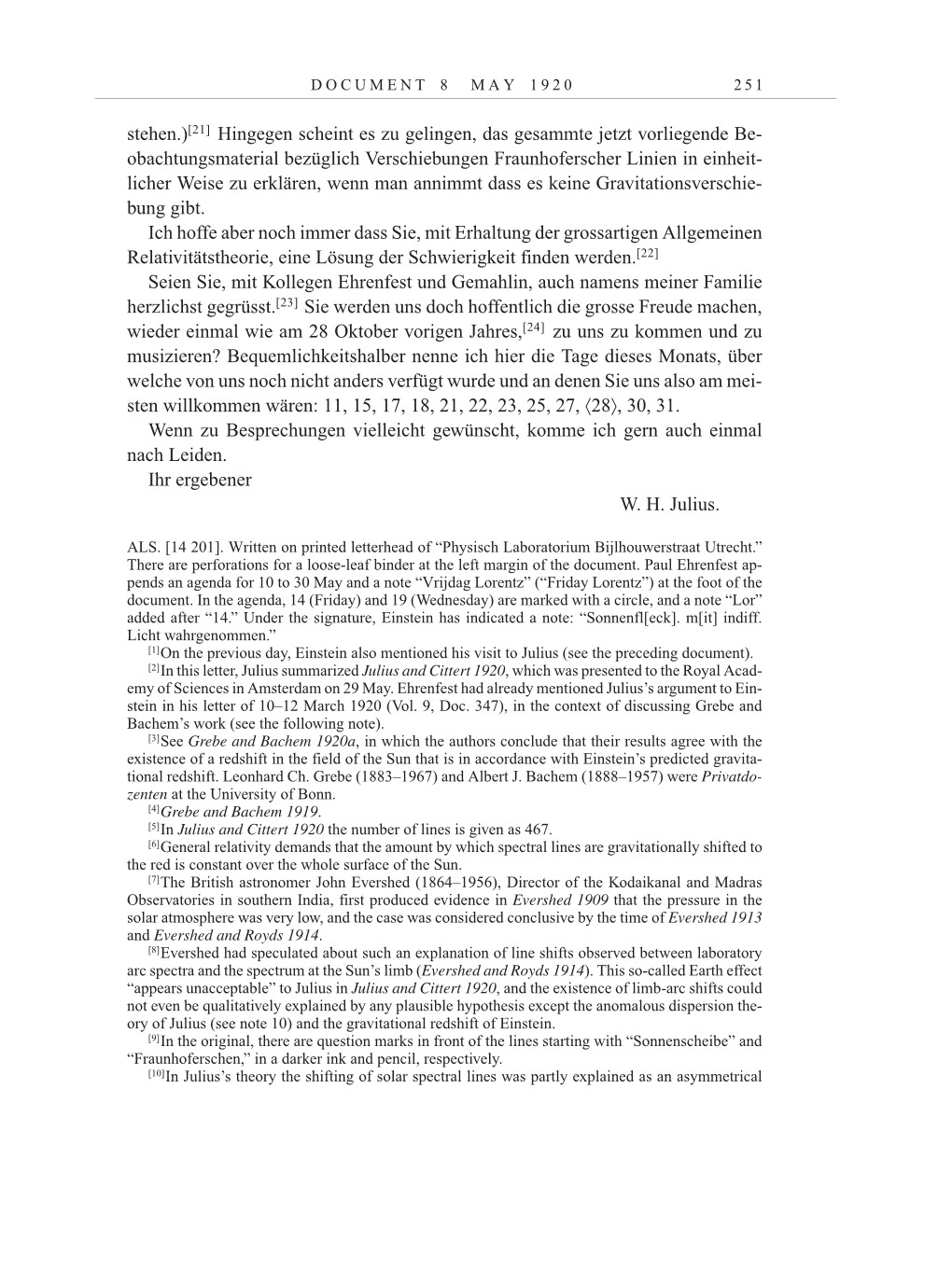D O C U M E N T 8 M A Y 1 9 2 0 2 5 1
stehen.)[21]
Hingegen scheint es zu gelingen, das gesammte jetzt vorliegende Be-
obachtungsmaterial bezüglich Verschiebungen Fraunhoferscher Linien in einheit-
licher Weise zu erklären, wenn man annimmt dass es keine Gravitationsverschie-
bung gibt.
Ich hoffe aber noch immer dass Sie, mit Erhaltung der grossartigen Allgemeinen
Relativitätstheorie, eine Lösung der Schwierigkeit finden
werden.[22]
Seien Sie, mit Kollegen Ehrenfest und Gemahlin, auch namens meiner Familie
herzlichst
gegrüsst.[23]
Sie werden uns doch hoffentlich die grosse Freude machen,
wieder einmal wie am 28 Oktober vorigen
Jahres,[24]
zu uns zu kommen und zu
musizieren? Bequemlichkeitshalber nenne ich hier die Tage dieses Monats, über
welche von uns noch nicht anders verfügt wurde und an denen Sie uns also am mei-
sten willkommen wären: 11, 15, 17, 18, 21, 22, 23, 25, 27, 28 , 30, 31.
Wenn zu Besprechungen vielleicht gewünscht, komme ich gern auch einmal
nach Leiden.
Ihr ergebener
W. H. Julius.
ALS. [14 201]. Written on printed letterhead of “Physisch Laboratorium Bijlhouwerstraat Utrecht.”
There are perforations for a loose-leaf binder at the left margin of the document. Paul Ehrenfest ap-
pends an agenda for 10 to 30 May and a note “Vrijdag Lorentz” (“Friday Lorentz”) at the foot of the
document. In the agenda, 14 (Friday) and 19 (Wednesday) are marked with a circle, and a note “Lor”
added after “14.” Under the signature, Einstein has indicated a note: “Sonnenfl[eck]. m[it] indiff.
Licht wahrgenommen.”
[1]On the previous day, Einstein also mentioned his visit to Julius (see the preceding document).
[2]In this letter, Julius summarized Julius and Cittert 1920, which was presented to the Royal Acad-
emy of Sciences in Amsterdam on 29 May. Ehrenfest had already mentioned Julius’s argument to Ein-
stein in his letter of 10–12 March 1920 (Vol. 9, Doc. 347), in the context of discussing Grebe and
Bachem’s work (see the following note).
[3]See Grebe and Bachem 1920a, in which the authors conclude that their results agree with the
existence of a redshift in the field of the Sun that is in accordance with Einstein’s predicted gravita-
tional redshift. Leonhard Ch. Grebe (1883–1967) and Albert J. Bachem (1888–1957) were Privatdo-
zenten at the University of Bonn.
[4]Grebe and Bachem 1919.
[5]In Julius and Cittert 1920 the number of lines is given as 467.
[6]General relativity demands that the amount by which spectral lines are gravitationally shifted to
the red is constant over the whole surface of the Sun.
[7]The British astronomer John Evershed (1864–1956), Director of the Kodaikanal and Madras
Observatories in southern India, first produced evidence in Evershed 1909 that the pressure in the
solar atmosphere was very low, and the case was considered conclusive by the time of Evershed 1913
and Evershed and Royds 1914.
[8]Evershed had speculated about such an explanation of line shifts observed between laboratory
arc spectra and the spectrum at the Sun’s limb (Evershed and Royds 1914). This so-called Earth effect
“appears unacceptable” to Julius in Julius and Cittert 1920, and the existence of limb-arc shifts could
not even be qualitatively explained by any plausible hypothesis except the anomalous dispersion the-
ory of Julius (see note 10) and the gravitational redshift of Einstein.
[9]In the original, there are question marks in front of the lines starting with “Sonnenscheibe” and
“Fraunhoferschen,” in a darker ink and pencil, respectively.
[10]In Julius’s theory the shifting of solar spectral lines was partly explained as an asymmetrical
